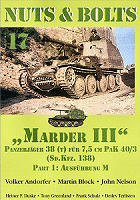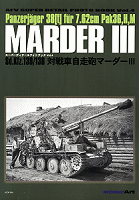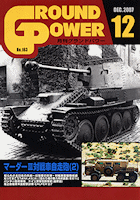| Introduction: |
Cyberhobby/Dragon continue their 38(t) series with this kit of the Sd.Kfz.138 Marder IIIM w/Stadtgas Initial Production that provides the early Marder III Ausf.M fitted with 2 stadtgas cylinders for use during training and delivery to units due to the shortages of gasoline for front line vehicles.
While the kit is labelled “Initial Production” the fact it has the outside mounted exhaust pipe would indicate it is more an Early/Mid Production as the prototypes and some Initial Production Marder III Ms had the internal mounted exhaust pipe with this quickly being altered to the outside exhaust pipe layout.| The kit: |
The kit again uses quite a few parts from the previous 38(t) kits along with a personal equipment sprue from the Gen2 figure sets (eg #6348) plus new parts such as the lower hull tub, upper hull panels and rear superstructure for the Marder M. Also included are the Stadtgas cylinders from the recent Panther Ausf.D w/stadtgas (kit #6346) to be used with this kit.
The kit consists of about 540 parts in light grey plastic although about 190 are indicated as not used with this kit, 16 in clear plastic (9 not used), two frets of etched parts, 3 lengths of pre-formed steel wire, a length of wire cable and a bag of individual track links plus of course the instruction sheet and a small decal sheets.
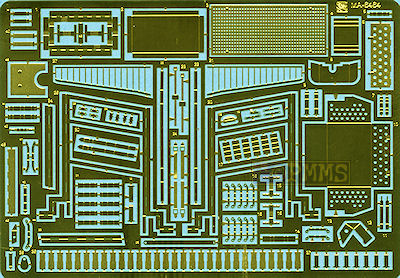  |
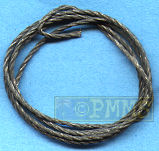  |
Standard of moulding is again excellent overall with very few if any pin marks with the detail very clean and crisp due to the many plastic ‘nodes’ on the parts that do require a bit of care when removing but worth the effort for the cleaner parts. There is also virtually no flash or other blemishes present with the track links which are cleanly moulded with just the usual small moulding seams to be cleaned from all the parts which is normal for any kit. A notable feature is the quite thin superstructure sides free of any pin marks along with details on both sides for a good appearance.
Dimensionally the kit matches the 1:35 Marder III M plans in the Panzer Tracts No.7-2 Panzerjaeger perfectly in all respects with any discrepancies being well within accepted tolerances.
The kit includes the forward transmission and driver’s seat as well as the detailed engine from the previous 38(t) kits but again you don’t get the etched steering levers from the 38(t) Ausf.G but just the plastic levers from the Aufkläerungspanzer 38(t) kit.
| Lower Hull: |
The lower hull tub has the floor and both sides moulded together as a conventional tub with well defined detail on underside and both sides of the hull walls for the forward compartment and inner final drives and includes revised upper walls for the Marder M hull as well as cut-outs for the engine intakes.
Detail on the tub exterior is very good with rivet detail on the bottom and sides as well as the idler mountings included with separate final drive covers and return roller mountings.
The separate front plate is in two parts to not compromise the detail on the upper and lower sections with the fit very good as is the separate tow hooks which have the correct profile but you should not attach this plate to the hull until the interior is done or there may be problems fitting the transmission/gearbox if you do attach the front plate now.
On the inside are two part final drive fittings and front brackets which fit snugly to the inner side walls with the transmission/gearbox having crisp details included for all the basic detail including the cooling ribs on the gearbox and textured drive shaft cover. The driver’s controls are in one piece and fairly basic but there are a couple of detailed etched sets available if you want to dress these up a bit?
There are still no driver’s foot pedals included and the three part seat is also very basic and there is also no driver’s instrument panel that should fit to the underside of the upper hull plate. As you can only see the interior through the transmission inspection hatch or the driver’s hatch if left open not a lot of the interior is visible in any case but if you’re going to include an interior providing all the main parts or none at all would seem the appropriate thing to do?
Once the transmission/gearbox is assembled this should be fitted inside the hull and you will have to flex out the front sidewalls slightly to insert the pins on the drive shafts (parts D46) into the final drive fittings (parts D55/56) and this is the reason for leaving the front plate separate as you won’t be able to flex the sidewalls to fit the transmission with the front plate in place.
The instructions show to fit the engine bulkhead inside the hull before the engine but if you do this it is a little difficult to fit the engine to the two floor mounting pins and it’s better the fit the engine first and then the firewall.
The kit has the full Praga TNHPS/II 6 cylinder petrol engine from the 38(t) Ausf.G kit with the rear radiator and associated fuel tanks to provide all the basic structures for a full engine compartment.
The engine block is in two halves with separate top rocker cover and a separate front bell housing with detailed fly wheel inside which is completely hidden after assembly but shows nice attention to detail. The detail on these parts is adequate but also a little plain on some when compared to photos such as the rocker cover but should be okay when looking through the open engine hatches.
Added to the engine are numerous accessories such as the alternator, carburettor and exhaust manifolds with the fit of the parts quite good overall and thankfully Dragon have fixed most of the instruction bloopers for the engine, but one still remains.
The location of the large exhaust manifold (part D16) is incorrect and it should be mounted above the lower intake manifold (part D23), not below as indicated.
Some of the smaller items are a little vague in their location and careful study of the instructions and pictures of the assembled engine will help to get things in the right place. The large air cleaning sort of “hangs” out in mid air but thankfully the locating of the parts is quite precise and so long as you make sure it is sitting at the right angle as the glue dries there shouldn’t be any problems.
You can of course finish off the engine by adding the wiring and plumbing from fine wire or sprue.
At the back is the large radiator with four parts, two for the radiator itself giving you nice mesh detail on one side only, the large fan coaming and a fairly basic later style fan moulded and not the usual fan on the 38(t) Praga engine. But this is not a big issue as the fan is all but hidden after assembly on this model even with the top engine hatches open.
There is a separate exhaust pipe that joins to the external exhaust pipe as well as the side mounted fuel tanks and again you can add the fuel lines and wiring to finish off. You should also fit the fuel tanks, especially the right side tank before adding the engine as you will not be able to fit this after the engine is in place.
After adding the fully painted fuel tanks and engine/radiator assemblies to the lower hull you can then fit the forward bulkhead/firewall which fit neatly over the engine flywheel with the exhaust pipe meeting the hull wall, don’t fit this into the hole in the sidewall as this must be left open to fit the long external exhaust pipe later in the assembly sequences.
The rear bulkhead/firewall also fits neatly into the hull tub and this has a separate round engine inspection hatch and right side intake detail which is visible as this bulkhead forms the front of the rear fighting compartment.
| Suspension: |
Each suspension bogie is made up of the hull mounting, two separate swing arms and the leaf spring unit and has a face plug that allows the arms to move but the springs are glued in place so there is only downward movement possible for the wheels after assembly. The fine mould lines on the springs are easy to remove with the bogie units fitting together as you attach to the hull side as the spring locating pin is on the hull side and also used to locate the bogie mounting plate. Also the bolt head detail on the bottom of the bogie mounting plate has been enhanced to better represent the actual bolt head sizes as they were for the 38(t) Ausf.G kit.
The wheels are the correct size and have the correct number of rim bolts (32) on both sides of the wheels with the hub bolts nicely defined and these simply glue to the axle stubs on the swing arms. These wheels have also had the detail between the rim and rubber tyre enhanced for a finer appearance adding a little more detail to the wheels as they were for the Flakpanzer 38(t) kit.
There are again two sets of drive sprockets provided; the original sprockets with the 8 lightening holes around the outer rim with these having basic details on the insides of the sprockets and revised solid sprockets without any lightening holes but with better defined inner hub rib detail included.
In the previous Ausf.G/Flakpanzer 38(t) kits there were two sets of sprockets with lightening holes, the original set with oversized holes and a revised set with correctly sized lightening holes.
For this kit one set of sprockets has been retooled for the solid sprockets but the sprockets with the correct sized lightening holes has been retooled leaving you with the other set of sprockets with oversized lightening holes.
Dragon were left with a bit of a dilemma as the previous sprockets with oversized holes had better defined inner hub/rib detail while those with the correct sized holes had more basic inner hub/rib details and the better option would have been to re-tool the sprockets completely taking the best of both combining the good hub/rib detail from one and the correct sized holes from the other to produce the ‘perfect’ holed sprocket. But I guess the bean counters won the day again leaving the sprockets in the kit with good hub/rib detail but oversized lightening holes.
But all is not lost; if you have the Flakpanzer 38(t) kit which requires solid sprockets you can swap those from this kit and use the correctly sized holed sprockets from the Flakpanzer 38(t) kit for this kit for an easy solution not withstanding the more basic inner detail on the sprockets.
Included are two sets of idler wheels, one with round lightening holes and the other with the teardrop shaped holes. The instructions just show the option but no indication which is more appropriate so checking references would be best to determine the parts best used but images indicate the teardrop is most common on the early Marder IIIMs.
The idler axle allows a little movement of the idler position so it’s best not to glue this in place until fitting the tracts for a better fit.
The return rollers have nice hub detail as well as the “continentau” embossing on the side wall but it’s a little oversized if you want to get real picky but will look good when painted and weathered to highlight the embossing, and it’s easy to convert the ‘u’ to an ‘l’ if you want to do this.
| Tracks: |
These are provided as individually moulded “magic tracks” which have nice detail including minute casting numbers on the edge of each link with no cleanup required.
The tracks are designed to be glued together and are not workable and you will have to incorporate the track sag as you glue the lengths together. By gluing a length together and letting the glue “go off” you can them add it to the suspension and add the curve around the drive sprockets and idlers as well as the track sag easier.
The assembled track runs look very good but if you prefer workable track links which take care of the track sag themselves then those from WWII Productions would be a simple alternative.
Note: the tracks and sprockets shown are from the 38(t) Ausf.G kit but the tracks are the same for this kit.


| Upper Hull Plates, Superstructure and Fenders: |
There is a new long one piece glacis plate for this kit but the glacis for the Flakpanzer 38(t) is still included so make sure you use the correct part C4 as indicated in the instructions. This has excellent rivet head detail with cut-outs for the separate cast driver’s hood and the engine inspection hatch which is a very snug fit to the glacis as is the fit of the driver’s hood with no trimming needed for either part.
The cast texture of the driver’s hood is very nicely done but there are very fine mould seam lines running around the top and care will be needed smoothing these out to not damage the cast effect. The lines are very fine so using the tip of a hobby knife should be enough to remove them and the two part driver’s hatches are free of any pin marks and fit to the hood nicely. There is no interior detail on the hatches and the real things have fairly substantial padding which you may want to add if leaving the hatches open?
The front visor port is also a separate part if you wanted to show open and the right side visor is also a separate part for better defined detail with the fit of the glacis to the hull tub being very good again not requiring any trimming to fit.
The barrel travel lock is made up of 5 parts and mounted next to the driver’s hood but there are couple of issues with the similar to those on the Marder III H travel lock.
At the base of the large lock post there should be a 2mm space between the lock and the bottom of the mounting plate (part E60) but this sits almost flush with the plate and the side of the mounting plate on the glacis is far too thick. This is due to the mounting plate designed with a small indent to fit over the top of the driver’s hood instead of the mounting plate being thinner and fitting into a recess in the hood as it should. Strangely the instructions show the hood with this recess and a thinner mounting plate but what is shown in the instructions has not made its way to the parts and a little work is needed to depict the mounting plate and travel lock spacing correctly.
1. No gap between lock and base plate 2. Base plate too thick.

Added to the front plate is the two part Notek light which has etched parts for the mounting and light aperture and you can add this now to later to avoid any damage during the rest of the assembly.
Added to the engine compartment are the four separate doors which again can be shown open or closed as you wish and these also fit very snugly together to form the top plate over the engine bay but note also the rear doors have the lower gun shields fitted to them as well as small grab handles in plastic. A nice detail touch is the grab handles moulded on the forward two doors are hollow unlike the solid blobs we often see for grab handles and this adds good definition to the doors.
As mentioned there are also the two Stadtgas cylinders to be added to the left of the glacis and you actually get three from the Panther D kit for one spare. These are moulded in one piece with just the side moulding seams to be removed and a separate end cap as well as preformed steel wire for the gas lines, etched cylinder straps and clips plus the plastic mountings. One of the wire gas lines runs around in front of the driver’s hood into the right side engine intake and it may be better not to fit this until after the side panels, glacis and driver’s hood are in place to enure proper fitting and also to prevent damage along the way.
The two large superstructure side panels are superbly moulded with rivet and panel detail on both sides without any hint of pin marks anywhere to contend with, there are also moulded a uniformly thickness or should that be thinness as the panels are commendably thin to avoid the bevelled edges seen on some previous kits and makes for excellent detail.
The right side panel also has the large engine louvers included which are again cleanly moulded apart from some very fine flash along a couple of the louvers that is easy to remove. Added to the sidewalls are the forward top and lower panels as well as etched intake screens for the underside of the engine intake overhangs and all these parts fit together perfectly without the need for any trimming.
One minor thing to watch is the etched intake screens have their numbers transposed in the instructions and you should fit these on the opposite sides from that indicated, but it’s not a big deal as they are hard to see on the final model anyway.
The fit to the full side is also very good making for quick and easy assembly but watch as there is a little movement and you should ensure they are aligned correctly. Using the underside bolted strips as a guide is one way of ensuring they align correctly and are not too far back on the hull sides and test fitting the rear hull panel in the process will also ensure correct alignment. The fenders should be added to the kit as you fit the side panels to align with the undersides of the superstructure overhand.
As with the previous 38(t) kits we have the perennial fender kink missing, looking at any photo of the Marder M, either the factory pilot models or serving production models will show a distinct fender kink but again the kit fenders are straight apart from a small kink at the rear to fit under the superstructure overhang. The locating ridge along the hill side is also straight but and it seems the straight fenders will remain in all 38(t) kits produced by Cyberhobby/Dragon.
I have included reference photos to fully illustrate the fender kink and I’m sorry of this again seems a little pedantic but we have seen some bizarre theories put up to explain their absence from the various Dragon 38(t) kits and as mentioned the feature is very noticeable on the Flakpanzer 38(t)/Marder III M fenders, even factory fresh vehicles.
The fenders themselves are very nicely done with the strengthening ridges raised on the top and indented on the undersides without any locating holes for the pioneer tools which are provided separate along with etched tool clips. Included in the instructions are overhead plan views of the fenders showing the location of the tools as well as the distinctive 38(t) perforated storage box in plastic or etched brass to allow you to fit these in the right places due to the absence of the locating holes and this does make for a cleaner appearance overall.
There are separate fender attachment brackets that fit to the hull side to add a little more definition but they are a little on the thick side and would be best replaced with etched items, the middle supports (parts G31/G32) are a little short and don’t quite reach the edge of the fender.
At the back is the large one piece rear hull plate with the upper hinged panel separate and this again is superbly moulded with not a pin mark to be seen as well as nicely defined rivet detail. It might be best to leave this panel off until all the interior components have been added for better access as the location of the firing platform is also not the best.
Once the rear panel has been attached there is the rear two part exhaust muffler and long single pipe that runs from the side engine louvers to the exhaust and this slips into the side louvers to fit into the hole in the hull side which it does okay and may take a little manoeuvring to get in place but nothing dramatic.
There is also provided an etched heat shield for the muffler and this has to be bent to a curve to fit around the muffler and annealing the part by running through a candle flame until red hot and let cool naturally will make bending the curve much easier.
Also added to the rear plate are the tow hook and wire rope brackets with the wire rope from the metal cable included which makes getting a natural coil quite easy as well as having cleaner detail definition.
| Fighting Compartment Interior: |
The lower floor with nice tread plate pattern is first added with the rest of the interior being nicely fitted out with the two side mounted periscopes in clear plastic with additional mountings, the radio set made up of multiple parts that again would look better with etched brackets plus racks for the gas mask canisters with etched brackets and MG42 on the left wall again with etched mounting brackets/clips and other smaller fittings.
The main features are the side mounted ammo racks/tubes and these are moulded quite cleanly with hollowed out tubes. The sides of the tubes are a little thick which is unavoidable in plastic and you may want to thin these a little for a better appearance and added to the top of the tubes are small etched extensions to give a good scale appearance. There extensions should actually have small kinks in them and not smooth as provided and you could add this kink for a more accurate appearance as well as adding the securing straps to each tube from this tape or lead sheet to finish off.
The ammo tubes have multi-part etched racks which will require careful bending and assembly as they are very thin and easily damaged, but will be more robust when the tubes are added. But the thinner racks add a nice detail touch to the finished items and there is also the smaller three round rack added further forward on the left wall.
Added to the back wall is the gun cradle support bracket which is provided as two options, one closed and one open support depending if the gun is in travel or firing mode which is a nice touch as well as two crew seats that have fairly basic fabric texturing included as does the third seat on the front right of the compartment.
The instructions show to add the upper PaK40 mounting plate (part E20) after fitting the superstructure sides but I found it easier to add part E20 before the superstructure sides for less interference and it also helps keep the hull top at the correct width in case of any slight bow-in that may be there.
| 7.5cm PaK40: |
The 7.5cm PaK40 gun comes from the previous PaK40 kits but only includes the plastic barrel along with a choice of the three different styles of muzzle brakes with all three styles seen in photos of Marder III Ms although the later rounded cap muzzle brake appears to be the most common and referring to reference photos if building a specific vehicle would be best.
The kit muzzle brakes are in one piece for the main muzzle brake using slide moulds and have separate end fillets with internal flanges. The rear breech block is very detailed with the breech made up of four main parts with a separate movable breech block of three parts plus breech opening handle, side piston and lower support for a very detailed barrel assembly.
If you wanted a metal barrel/muzzle brake then there are plenty available for the PaK40 such as those from ABER that will fit to the kit gun without any problems.
The gun cradle is in the usual two halves for this type of gun and is the correct length with the rest of the gun cradle being nicely detailed with many separate parts and alternate front cradle panel, separate side trunnion supports, two part recoil cylinders, traverse hand wheels and smaller fittings for a very busy assembly.
There are a couple of new mounting parts for the Marder III M but other than that the gun is the same as before and goes together without any real problems.
The main curved gun shield is in one piece which fits to the front of the gun mounting and between the two superstructure sides with the whole gun sitting on the large gun mounting that fits between the hull sides.
As a bonus there is a selection of 7.5cm ammo boxes, round canisters and 7.5cm rounds and empty shell casings to use in diorama settings.
| Decals: |
There are two small decal sheets included, one from the Panther D Stadtgas (kit #6346) with three balkenkreuz and vehicle name “Fahrschule” which is is German for "Driving School" therefore it could apply to any vehicle used for driver training (best to check references) and the other from the PaK40 (kit #6250) with stencilling for the 7.5cm rounds and ammo boxes.
It should be noted that the vehicle markings, balkenkreuz and unit markings were not applied at the factory level but only when the vehicles were delivered to the respective units and as the Stadtgas fitted Marders were only used for training/testing and delivery in it unlikely they had any markings applied?
But there are exceptions to everything as we often see and if there is a specific image available of one Stadtgas Marder with balkenkreuz then that’s fine but it doesn’t mean a thing for the majority.

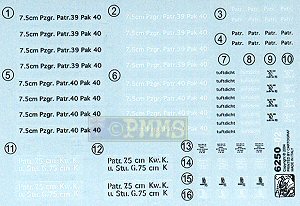
Clear parts



| Instructions: |
These are the usual exploded view drawings but are very busy in places and can be confusing unless you study them very closely before any assembly but apart from a few miss-numbered parts there weren’t any real problems if the usual care is taken.
| Conclusion: |
This is another overall well done kit from Cyberhobby/Dragon of the Early/Mid Production Marder III Ausf.M with only a few issue to contend with as you will find on any kit. The kit is cleanly moulded with good fit of the parts for a fairly easy if a little busy build in parts and if you leave off the Stadtgas cylinders you will have a respectable model of the Early/Mid Marder III Ausf.M to boot.
The interior is quite extensive but fairly basic in detail overall as with other Cyberhobby/Dragon 38(t) kits but if you are building the model buttoned up you can leave out the interior and save a bit on assembly time leaving just the nicely done exterior and fighting compartment.
This also gives a preview of what we can expect in the Marder III Ausf.M Initial Production (kit #6464) to follow shortly which will have the internal exhaust pipe layout.
Highly recommended 8/10
See the Pz.38(t) subjects page for additional reviews of 38(t) kits and accessories.
| The Sprues: |
Click on thumbnails for larger view













Detail Images




Click Browsers BACK button to return to page




